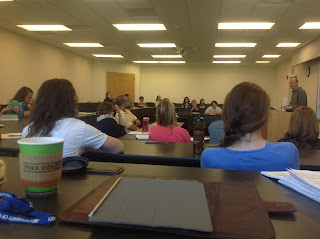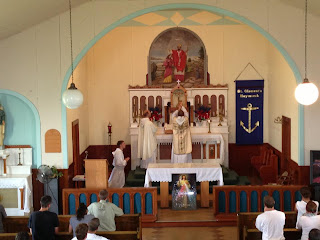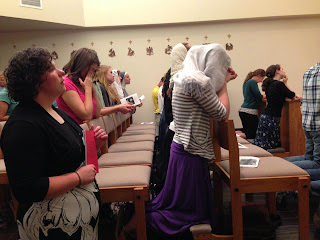This month, I have the joy of serving as the music director at the Ecclesia Institute, a 5-week program of formation in philosophy and theology, structured in the monastic schedule of the Community of St. John, taking place at the University of Mary in Bismarck.
 |
| A class given by one of the priests |
The students, coming from many different backgrounds and from all around the U.S., are receiving a sort of “immersion experience” in sacred music and liturgy. In addition to the offices being sung, we’ve had sung Masses in the Ordinary Form of the Roman rite every day of the institute. The priests sing the dialogues, collects, preface, etc. and the propers are chanted every day, sometimes in English (SEP), sometimes using the Gregorian melodies, and the singing of the Gregorian Gradual and Alleluia is often heard instead of the responsorial psalm and acclamation-style Alleluia. The ordinary is always sung, sometimes in Gregorian melodies, sometimes in English adaptations thereof. There are also organ improvisations and repertoire punctuating the liturgies, especially on Sundays and feasts, the readings are sung on Sundays and feasts, and sometimes hymns are used at the end of Mass. Yesterday, we went to a local parish for the celebration of a missa cantata without incense in the Extraordinary Form of the Roman rite, and will do so again on the feast of St. James. For many of the participants, it was their first exposure to the Traditional Latin Mass.
 |
| Ordinary Form Mass in a simple country parish, following four days of intense hiking and camping |
All of these experiences have been accompanied by classes on basic principles of sacred music and sacred liturgy, giving them them the opportunity to learn about the Church’s traditions and sacred treasures in an academic style, but also giving free reign to honest questions about the experiences and ideas presented to them.
What has been the result? I’ve been asking around to gauge the honest reactions of people who haven’t had experiences of liturgy and sacred music like this before, and there’s an amazing docility to receiving the Church’s treasures of sacred music and sacred liturgy. Many have made comments about the positive impact the experience has had on their ability to pray and sense God’s presence in the liturgy. Most had never heard a Gregorian Gradual or Alleluia sung before, but they have found them capable of prompting the heart to contemplation of scripture. Because so much of the music is a capella, they have really enjoyed the sound of the organ when it does make an appearance, and it really adds to the festivity of the day. Others have a preference for “praise and worship”-style music, but through the encouragement of the priests, they have cultivated an openness to something new and different, thereby receiving it with more joy than they might otherwise have done, and it does seem to be growing on them. The overall feeling, though, is one of being excited about the opportunity to learn how to pray from a liturgy well-celebrated, as well as excitement about the authentically Catholic and sacred character of the liturgy.
 |
| Ecclesia participants at prayer following celebration of the Extraordinary Form of the Roman rite in the chapel of a local parish |
What can we draw from an experience like this?
I think the lesson lies in allowing the liturgy to shine as it is, rather than hoping for it to be something that it’s not.
Directors of religious education, campus ministers, and priests are often overly-sensitive to letting the liturgy radiate through a devotion to celebrating it with a marked sense of the sacred. The result is a labored, often artificial (or even banal) feeling in the liturgy, fearful that something marked by silence, repetition, and transcendence might offend someone, or not engage them because its appeal doesn’t lie firstly in the emotions. Convinced that the emotions are the first and most direct route to engaging young people, they opt for modes of celebrating the Mass that focus in on the excitement of the passions, relying on the energy of the human heart thereby stirred up to reach God. Resorting to the notion of self-expression, these efforts often block the full glory of God’s gift of Himself as the “prime mover” in the liturgy, and the liturgy ends up being horizontal and closed in upon itself.
The liturgy, properly celebrated, has a distinct identity, and that identity has great currency for young people looking for their calling, hoping to identify their gifts, searching for what they have to offer to God, His Church, and the world. Why give them a liturgy that is really just trying to be like an evangelical “worship service” plus Eucharist? That’s not terribly Catholic, and the liturgy (and by extension, the faith of young people) can’t long bear being something it is not before it disintegrates. Chant, Latin, ad orientem, beautiful vestments and vessels, meaningful and simple gestures – these are Catholic in their character, and give young people something meaty to chew on, something beyond themselves to grasp. They also offer something that recognizes that young people are looking for something substantive, something real, and that they aren’t just narcissistic, unintellectual libertines.
If we don’t seriously engage them in their faith with all the treasures of the Church in hand, who will?
Beyond that, though, the notion of making the liturgy into a didactic experience through explaining everything whilst going on with the celebration of the Mass is a tired, frumpy one. In an age when media offer a total immersion experience that relies on images, gestures, symbols (and not text alone), and end up having a formative effect as a result, why not allow the liturgy to be this way? Liturgy is a sort of holy Gesamtkunstwerk, a total experience for the senses. We see God, the source of Beauty in the gestures, architecture, and sacred art; we hear the voice of God in scriptures, music, and prayers; we smell the rising of our prayers to Him in the incense; we feel Him in the movement of the body between different postures of prayer; and ultimately we taste Him in the reception of Holy Communion. God doesn’t only teach through explanations; He reaches hearts through the penetration of the senses with beauty, silence at key points, solemnity, and a sense of the sacred. Why be frightened of the liturgy’s import, seeking to cover it with explanations and overly-emotional, often effeminate music?
If the liturgy has a palpable character of sacrality, the hearts of young people are allowed to encounter the Lord rather than just the people around them. Rather than experiences which point only to the human, the passionate, the horizontal, why not allow the liturgy to shine in its character which perfectly balances the horizontal and vertical in the Incarnation and Cross of Christ?
Allow the liturgy to be as it is – a gift from God and vehicle of His grace to us. Channel your efforts into celebrating the liturgy in accordance with its innate character, rather than working to explain away that character. Don’t be afraid that doing so will drive away young people – you might very well find that the contrary is true! Prepare young people for a lifetime of faith with a liturgy that bears the weight of repetition. Don’t settle for something that just seems to fit the bill while they’re young.




